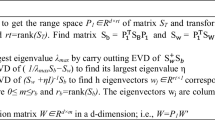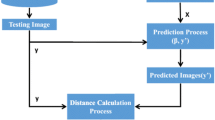Abstract
Linear discrimination analysis (LDA) technique is an important and well-developed area of image recognition and to date many linear discrimination methods have been put forward. Despite these efforts, there persist in the traditional LDA some weaknesses. In this paper, we propose a new LDA-based method that can overcome the drawback existed in the traditional LDA method. It redefines the between-class scatter by adding a weight function according to the between-class distance, which helps to separate the classes as much as possible. At the same time, in this method, we firstly remove the null space of total scatter matrix which has been proved to be the common null space of both between-class and within-class scatter matrix, and useless for discrimination. Then in the lower-dimensional projected space, the null space of the resulting within-class scatter matrix is calculated. This lower-dimensional null space, combined with the previous projection, represents a subspace of the whole null space of within-class scatter matrix, and is really useful for discrimination. The optimal discriminant vectors of LDA are derived from it. Experiment results show our method achieves better performance in comparison with the traditional LDA methods.
Access this chapter
Tax calculation will be finalised at checkout
Purchases are for personal use only
Preview
Unable to display preview. Download preview PDF.
Similar content being viewed by others
References
M. Turk and A. Pentland, “Eigenfaces for recognition,” Int. J. Cog. Neurosci., vol. 3, no. 1, pp. 71–86, 1991.
W. Zhao, R. Chellappa, and P.J. Phillips, “Subspace Linear Discriminant Analysis for Face Recognition”, Technical Report CAR-TR-914, Center for Automation Research, University of Maryland, 1999.
D. L. Swets and J. J. Weng, “Using discrimination eigenfeatures for image retrieval,” IEEE Trans. Pattern Anal. Machine Intell., vol. 18, pp. 831–836, Aug. 1996.
P. N. Belhumeur, J. P. Hespanha, and D. J. Kriegman, “Eigenfaces vs. fisherface: Recognition using class specific linear projection,” IEEE Trans. Pattern Anal. Machine Intell., vol. 19, pp. 711–720, July 1997.
H. Yu and J. Yang, “A direct LDA algorithm for high-dimensional data with application to face recognition,” Pattern Recognit., vol. 34, no. 12, pp. 2067–2070, 2001.
M. Loog, R. P. W. Duin, and R. Haeb-Umbach, “Multiclass linear dimension reduction by weighted pairwise fisher criteria,” IEEE Trans. Pattern Anal. Machine Intell., vol. 23, pp. 762–766, July 2001.
A. M. Martinez and A. C. Kak, “PCA versus LDA,” IEEE Trans. Pattern Anal. Machine Intell., vol. 23, pp. 228–233, Feb. 2001.
D. H. Foley and J. W. Sammon, “An optimal set of discrimination vectors,” IEEE Trans. Comput., vol. C-24, pp. 281–289, Mar. 1975.
R. A. Fisher, “The use of multiple measurements in taxonomic problems,” Ann. Eugenics, vol. 7, pp. 178–188, 1936.
Rui Huang; Qingshan Liu; Hanqing Lu; Songde Ma, “Solving the small sample size problem of LDA” Pattern Recognition, 2002. Proceedings. 16th International Conference on, Volume: 3, 11–15 Aug. 2002 Pages:29–32 vol.3
C. Liu and H. Wechsler, “Robust coding scheme for indexing and retrieval from large face databases,” IEEE Trans. Image Processing, vol. 9, pp. 132–137, Jan. 2000.
Chengjun Liu; Wechsler, H. “A shape-and texture-based enhanced Fisher classifier for face recognition,” IEEE Trans. Image Processing, vol. 10, pp. 598–608, Apr. 2001.
L. Chen, H. M. Liao, M. Ko, J. Lin, and G. Yu, “A new LDA-based face recognition system which can solve the small sample size problem,” Pattern Recognit., vol. 33, no. 10, pp. 1713–1726, 2000.
“ORL face database”: www.uk.research.att.com/facedatabase.html
Author information
Authors and Affiliations
Editor information
Editors and Affiliations
Rights and permissions
Copyright information
© 2005 Springer-Verlag Berlin Heidelberg
About this paper
Cite this paper
Nhat, V.D.M., Lee, S. (2005). An Improvement on LDA Algorithm for Face Recognition. In: Kurzyński, M., Puchała, E., Woźniak, M., żołnierek, A. (eds) Computer Recognition Systems. Advances in Soft Computing, vol 30. Springer, Berlin, Heidelberg. https://doi.org/10.1007/3-540-32390-2_36
Download citation
DOI: https://doi.org/10.1007/3-540-32390-2_36
Publisher Name: Springer, Berlin, Heidelberg
Print ISBN: 978-3-540-25054-8
Online ISBN: 978-3-540-32390-7
eBook Packages: EngineeringEngineering (R0)




